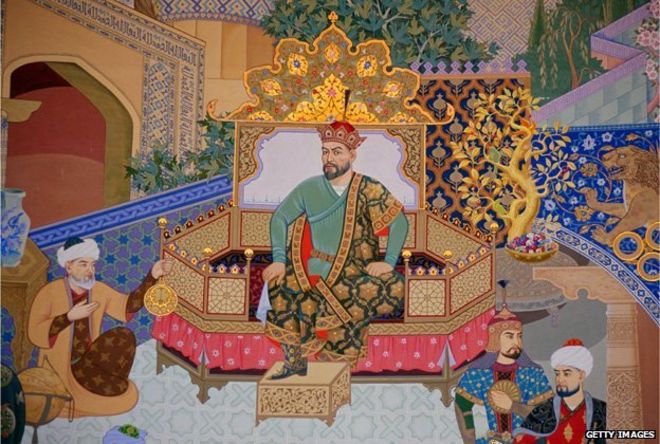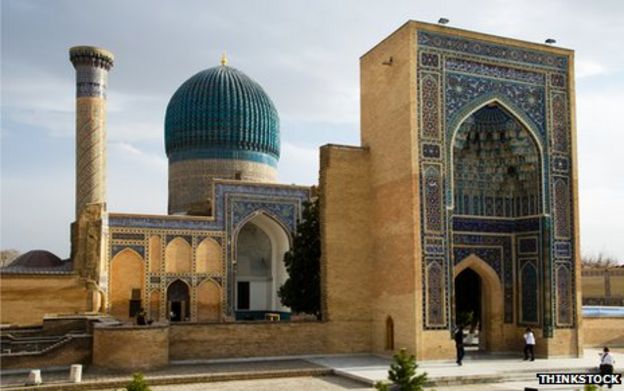Disability history month: Was Tamerlane disabled?

Tamerlane – derived from his nickname Timur the Lame – rose from obscurity to become a 14th Century conqueror of nations, who piled high the skulls of his enemies. It was quite a feat at a time when physical prowess was prized, writes Justin Marozzi.
Think of the greatest conquerors of all time and chances are you’ll quickly list Genghis Khan and Alexander the Great. It is rather less likely, unless you come from Central Asia or the Muslim world more widely, that you’d spare a thought for Tamerlane.
Yet in many ways this Tartar warlord, born near Samarkand in 1336 in what is now Uzbekistan, outshone both the Macedonian king and the Mongol warlord.
Unlike Alexander, Tamerlane was not of royal blood, but came from humble stock.
He began his world-conquering rampages as a petty sheep-rustler among the steppes and high mountain passes of Central Asia.
And unlike Genghis, he did not have one people to lead to military triumphs, but had to weld together a successful army from a bewildering mass of different, often fractious, nationalities. By the time he faced the Ottoman Sultan Bayazid I on the battlefield in 1402, his soldiers came from the length and breadth of his empire, from Armenia to Afghanistan, Samarkand to Siberia.
Overcoming these disadvantages was one thing. More striking and startling by far was the fact that Tamerlane was severely disabled in his right side.
At birth he was given the name Timur, meaning iron, which later gave rise to the pejorative Persian version, Timur-i-lang (Timur the lame), after a devastating injury he suffered to both right limbs in his youth. From there it was only a slight corruption to Tamburlaine and Tamerlane, the names by which he is better known in the West.
Such a physical disability, at a time when martial skills were a prerequisite of political power, would have been a crushing blow for most men.
The young Tamerlane would have known the local proverb “only a hand that can grasp a sword may hold a sceptre”. Self-advancement in this brutal world was inconceivable without excelling in hand-to-hand combat and mounted archery.
The sources leave us in no doubt about the injury, although there is uncertainty over exactly how it occurred. It probably happened in about 1363, when Tamerlane was serving as a mercenary for the Khan of Sistan in Khorasan, in what is today the Dasht-i-Margo (“desert of death”) in south-west Afghanistan.
Another source – the extremely hostile Ibn Arabshah, a Syrian chronicler from the 15th Century – says a watchful shepherd spied Tamerlane prowling about his flock of sheep, smashed his shoulder with one well-directed arrow and loosed off another into his hip for good measure.
“Mutilation was added to his poverty and a blemish to his wickedness and fury,” writes the Syrian with a contemptuous flourish.
Clavijo, the Spanish ambassador who visited Samarkand in 1404, records how Tamerlane encountered a large party of horsemen from Sistan, who slaughtered many of his men.
“Him too they knocked off his horse, wounding him in the right leg, of which wound he has remained lame all his life (whence his name of Timur the Lame); further he received a wound in his right hand, so that he has lost the little finger and the next finger to it.”
A Soviet archaeological team led by Mikhail Gerasimov opened Timur’s exquisite tomb in Samarkand in 1941 and found that he was a “lame”, well-built man of about 5ft 7in.
An injury to his right leg, where the thighbone had merged with his kneecap, left it shorter than the left, hence the pronounced limp referred to in his scornful nickname.
When walking, he would have dragged his right leg, and his left shoulder was found to be unnaturally higher than the right. Further wounds were discovered to his right hand and elbow.

For his 14th Century enemies, such as the Ottoman emperor and the rulers of Baghdad and Damascus, Tamerlane’s lameness provided an easy opportunity to sneer – but mockery was easier than beating him in battle.
Even Arabshah, his fiercest critic, acknowledged that he was “mighty in strength and courage”, a “spirited and brave” leader who “inspired awe and obedience”.
One can sense the great 18th Century historian Edward Gibbon almost warming to Tamerlane, whose ferocious military genius has never really received its historical due:
“The nations which he vanquished exercised a base and impotent revenge; and ignorance has long repeated the tale of calumny, which had disfigured the birth and character, the person, and even the name, of Tamerlane.
“Yet his real merit would be enhanced, rather than debased, by the elevation of a peasant to the throne of Asia; nor can his lameness be a theme of reproach, unless he had the weakness to blush at a natural, or perhaps an honourable, infirmity.”
By the time he died, en route to war with the Ming emperor of China in 1405, Tamerlane was undefeated on the battlefield after 35 years of constant campaigning.
Rarely can any man, let alone an aspiring world conqueror, have overcome physical disability with such terrifying ease, as hundreds of thousands of Asians, brutally slaughtered and decapitated, discovered to their cost.
Justin Marozzi is the author of Tamerlane: Sword of Islam, Conqueror of the World http://www.bbc.co.uk/news/magazine-20538810
